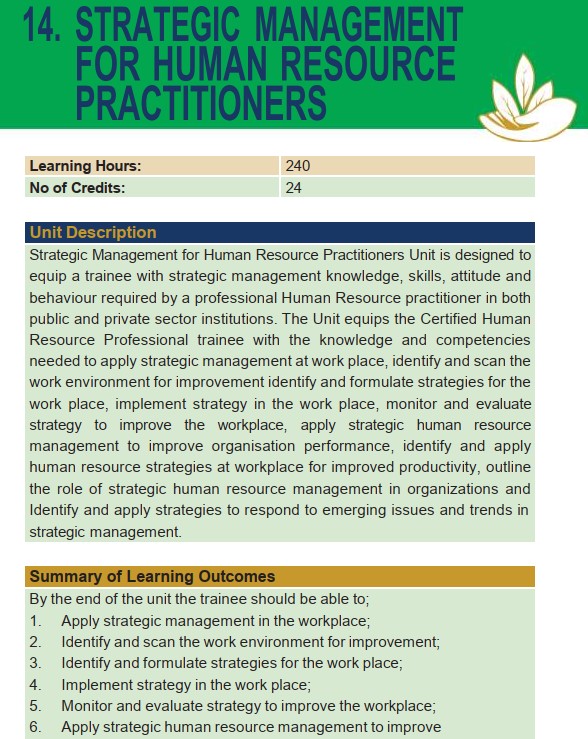
Topics
1. Introduction to Strategic Leadership
1.1 Leadership concepts
1.2 Principles of leadership
1.3 Theories and approaches of leadership
1.4 Objectives of leadership
1.5 Leadership development
1.6 Types of leadership
1.7 Leadership power
1.8 Sources of power for leadership
1.9 Features of leadership
1.10 Levels of leadership
1.11 Functions of a leader
2. Leadership Behaviour
2.1 Introduction to leadership behavior
2.2 Key components of Leadership-and behavioural competencies {this include:
(a) Setting and implementing a vision and direction for the HR function; and
(b) Leading organisational initiatives; influencing and supporting other organisational members and leaders};
2.3 Leadership attitudes
2.4 Leadership styles
2.5 Leadership qualities
2.6 Leadership skills
2.7 Leadership traits
2.8 Leadership and integrity
2.9 Legal framework in leadership and integrity
2.10 Leadership navigation
3. Ethical Practice of Personal Integrity, Professional Integrity, and Ethical Issues in Organisational
3.1 Introduction to ethics and integrity
3.2 Creating and driving an ethical organisational environment and behaviour. [Behaving in an ethical manner that promotes high standards of integrity and the organisation’s values].
4. Personal integrity
4.1 Consistency between espoused and enacted values
4.2 Personal mistakes and demonstration of accountability for actions
4.3 Recognize biases [Recognition of personal biases and the biases of others, and taking steps to increase self-awareness]
4.4 Role models [Serving as a role model of personal integrity and high ethical standards]
4.5 Unethical behaviour [Brings potential conflicts of interest or unethical behaviours to the attention of senior leaders and other executives], and
4.6 Helping others to identify and understand their biases
5. Professional Integrity
5.1 Dealing with political pressure [Withstand politically motivated pressure when developing or implementing strategy, initiatives or long-term goals]
5.2 Ethics, integrity and organisation success [Balance ethics, integrity, organisational success, employee advocacy and organisational mission and values when creating strategy, initiatives or long-term goals]
5.3 Ethical human resource team [Establish the HR team as a credible and trustworthy resource]
5.4 Promote the alignment of HR and business practices with ethics, laws and standards
5.5 Ethical decision making [make difficult decisions that align with organisational values and ethics]
5.6 Power, authority and ethics [Apply power or authority appropriately]
6 Ethical Agent
6.1 Learning, development and ethics [Design learning and development programs covering ethics]
6.2 Organisational culture, systems and ethics [Implement and maintain a culture and organisational system that encourages all employees to report unethical practices and behaviors].
6.3 Employee empowerment and ethics [Empowers all employees to report unethical behaviors and conflicts of interest without fear of reprisal]
6.4 Mitigating bias in human resource and organization business [Take steps to mitigate the influence of bias in HR and business decisions]
6.5 Transparency and ethics [Maintain appropriate levels of transparency for HR programs, practices and policies]
6.6 Ethical risks in an organization [Identify, evaluate and communicate to leadership potential ethical risks and conflicts of interest]
6.7 Organisational ethical standards and policies [develop and implement standards and policies and ensure that staff members have access to and understand the organization’s ethical standards and policies
6.8 Ethics in corporate governance
7 Legal Framework of Ethics and integrity in Kenya
7.1 The conditional provisions of ethics and integrity
7.2 Legislative provisions of ethics and integrity
8 Fundamentals of Governance and Corporate Governance
8.1 Introduction to governance
8.2 Introduction to corporate Governance
8.3 Objectives of governance and Corporate Governance
8.4 Theories of governance
8.5 Corporate governance theories
8.6 Models of corporate governance
8.7 Principles of governance and practice
8.8 Principles of corporate governance practice
8.9 Pillars of corporate governance
8.10 Benefits and challenges of governance
8.11 Benefits and challenges of corporate governance
8. 12 Corporate governance failure
8.13 Contemporary issues in governance and corporate governance
9 Corporate Governance Practices and Reporting
9.1 Responsibilities and functions of board of directors
9.2 Composition of the board of directors
9.3 Board charter
9.4 Board committees
9.5 The audit committee
9.6 Directors’ remuneration
9.7 Reporting on corporate governance
9.8 Board and committee meetings
9.9 Board evaluation
9.10 Governance audit
9.11 Role of board chair and secretary
9.12 Corporate governance designs in selected countries
10 Stakeholders in Governace and Corporate Governance
10.1 Stakeholder mapping
10.2 Classification of stakeholders
10.3 Importance of stakeholder management
10.4 Model of stakeholder management
10.5 Stakeholder communication
10.6 Challenges in stakeholder management in corporate governance
11 Enterprise Architecture Governance
11.1 Introduction to enterprise architecture Governance
11.2 Theories of enterprise architecture governance
11.3 Principles of enterprise architecture Governance
11.4 Enterprise architecture governance processes
11.5 Objectives of enterprise architecture Governance
11.6 Components of enterprise architecture governance
11.7 Enterprise architecture approaches
11.8 Enterprise architecture framework
11.9 Enterprise architecture tools
11.11 Enterprise architecture compliance
11.12 Benefits and challenges of enterprise architecture governance
12. Corporate Governance Tools
12.1 Board almanac and work plan
12.2 Resource utilisation
12.3 Corporate governance philosophy
12.4 Role descriptions
12.5 Code of conduct and ethics
12.6 Policies and procedures
12.7 Communication network platforms
12.8 Register of interests
12.9 Stakeholder engagement
12.10 Board charter
12.11 Strategic plan
12.12 Leadership and integrity guidelines
12.13 Compliance reports
12.14 Risk management reports
13. Organisational Risk Management
13.1 Introduction to organisation risk management
13.2 Objectives of risk management
13.3 Risk management policy and framework
13.4 Organization risk assessment
13.5 Organization risk management strategy
13.6 Risk management process
13.7 Benefits and challenges of risk management
13.8 Risk register
13.9 Organisational risk governance
13.10 Internal controls
14. Business Continuity Planning
14.1 Introduction to business continuity planning
14.2 Objectives of business continuity planning
14.3 Theories of business continuity planning
14.4 Principles of business continuity planning
14.5 Business continuity planning policy
14.6 Stages of business continuity planning
14.7 Business continuity planning tools
14.8 Business continuity planning team
14.9 Benefits and challenges in business continuity planning
15. Emerging Issues and Trends in Corporate Governance and their ICT Applications
15.1 Global emerging issues and trends in governance and corporate governance
15.2 Mitigation measures for emerging issues and trends in governance and corporate Governance
